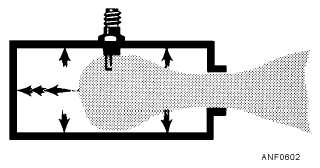When you burn fuel in a container that has an
opening (or nozzle) at one end, expanding gases rush
out of the nozzle at a high velocity, as shown in figure
6-2. Releasing internal pressure at the nozzle end of the
container leaves an unbalanced pressure at the other
end. The released pressure moves the container in
the direction opposite to that of the escaping gases.
This is the basic operating principle for all jet
engines. Obviously, propulsion depends solely on
internal conditions. The container does not "push
against" external air. In fact, a complete vacuum would
produce even greater force.
The jet propulsion engine operates like a toy
balloon. Newton's third law of motion explains this
operation. This law states "for every acting force there
is an equal and opposite reacting force."
Inflate a
balloon. The air pressure inside the balloon, which is
stretching the skin, is greater than the pressure outside
the balloon. If the stem is tied closed, the inside air
pushes in all directions and the balloon will not move.
Place the balloon in a vacuum and release the stem. The
escaping air has nothing to push against, but the balloon
will move in a direction away from the stem, just as it
does in a normal atmosphere.
Releasing the stem removes a section of skin on the
side of the balloon against which the air has been
pushing. On the side directly opposite the stem,
however, the air continues to push on an equal area of
skin. The continued push of air on this area causes the
balloon to move in the direction away from the stem.
The acting force that Newton's third law refers to is
the acceleration of the escaping air from the rear of the
balloon. The reaction to this acceleration is a force in
the opposite direction. In addition, the amount of force
acting on the balloon is the product of the mass of air
being accelerated times the acceleration of that air.
Since the forces always occur in pairs, we can say that if
a certain force is needed to accelerate a mass rearward,
the reaction to this force is thrust in the opposite
direction (force = thrust, as shown in figure 6-3).
RAMJET ENGINES
The ramjet is often described as a flying stovepipe.
It is the simplest of all power plants that use
atmospheric air to support combustion.
A ramjet is an appropriately shaped duct, tapered at
both ends, in which fuel is injected and burned at a
constant pressure, as shown in figure 6-4. Except for the
possibility of fuel pumps or other accessories, there are
no moving parts.
The air inlet diffuser of the ramjet engine is
designed to convert the velocity energy of the entering
air into static pressure. This is commonly known as
ram. During the inlet process, fuel is injected into the
airstream, where it is well mixed with the air so that it
will burn readily. At about the point of highest pressure
in the engine, combustion is initiated and the fuel-air
mixture is burned. The gases of combustion and the
heated air expand, thus air is ejected from the exit
nozzle at a much higher velocity than it had when it
entered the engine. This change in the velocity of the
entering and departing air results in the thrust.
PULSEJET ENGINES
The pulsejet engine is a member of the athodyd
(aero-thermodynamic-duct) family, since it does not
have a compressor or a turbine.
The pulsejet engine differs from the ramjet in that
the inlet duct is sealed with a disc that incorporates
flapper valves. The purpose of the flapper valves is to
provide the required air intake system, seal the
high-pressure gases in the combustion chamber, and
prevent their escape out the inlet duct during the
combustion
cycle.
A
pulsejet
engine
consists
essentially of a diffuser, an air valve bank (automatic or
6-2
Figure 6-2.—Principle of jet propulsion.

